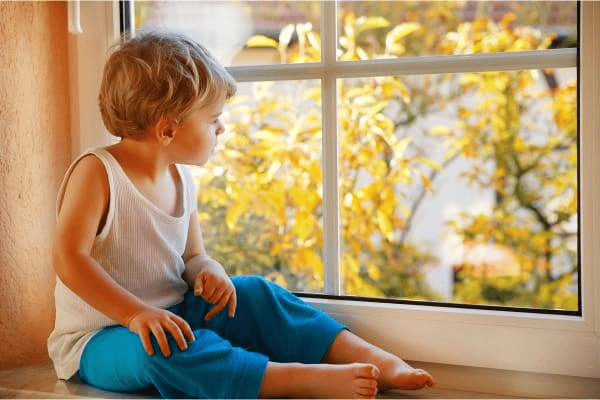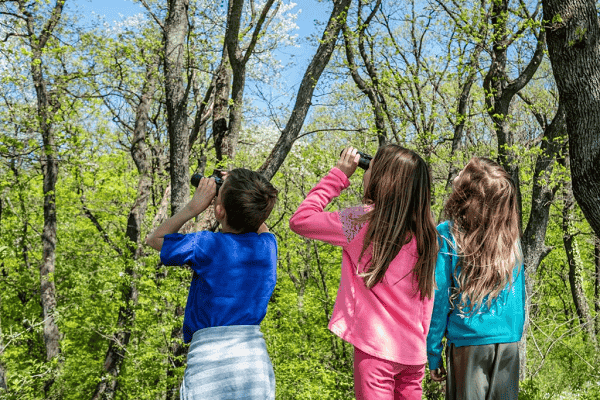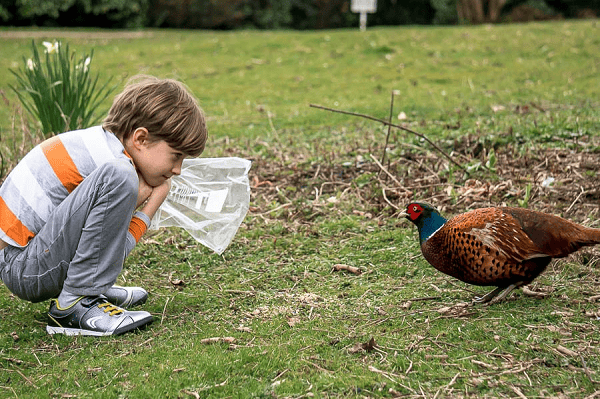Today we’ll guide you How To Get Kids Interested In Birdwatching.
Did you know that birdwatching is not just a hobby for adults? Research shows that engaging children in birding at a young age can have significant benefits for their cognitive development, emotional well-being, and environmental awareness.
Introducing your child to the world of birdwatching can open their eyes to the wonders of nature and create lasting memories. But how do you spark their interest and make birding a fun and engaging activity? In this article, we will provide you with expert tips and strategies to get your kids excited about birdwatching, transforming them into enthusiastic young birders.
Key Takeaways:
- Start birdwatching right in your own backyard
- Create a comfortable indoor birdwatching station for bad weather days
- Let your kids make decisions about birdwatching activities
- Turn regular outings into birding adventures
- Join local birding groups to foster a sense of community
Start Birdwatching In Your Backyard
One of the best ways to introduce kids to birdwatching is by starting right in your own backyard. Not only is it convenient, but it also provides a familiar and comfortable environment for your kids to begin their birdwatching journey. By creating a bird-friendly space, you can attract different bird species, making birdwatching an exciting and educational experience for your kids.
To start birdwatching in your backyard, here are a few tips:
- Provide a variety of bird feeders and bird baths to attract different types of birds. Make sure to clean and refill them regularly to maintain a welcoming environment for our feathered friends.
- Plant native plants and flowers that attract birds with their nectar, fruits, or seeds. Research the types of birds that are common in your area and choose plants that suit their preferences.
- Create natural habitats such as shrubs, trees, and bushes that offer shelter and nesting sites for birds. These will not only provide safe spaces for birds to rest but also increase their chances of visiting your backyard.
- Add birdhouses or nesting boxes around your yard to invite bird families to settle in. Make sure to place them at the proper height and in suitable locations for the specific bird species you want to attract.
By implementing these strategies, you can transform your backyard into a bird haven and encourage your children to observe and learn about the fascinating world of birds. Additionally, keeping a journal or a birding log can help track the different species that visit your backyard, creating a fun and educational activity for your kids.
Remember, the key to starting birdwatching in your backyard is to provide a welcoming environment that attracts a variety of birds. By engaging your kids in this outdoor adventure, you ignite their curiosity and foster a lifelong love for nature and birding.
| Bird-Friendly Elements | Benefits |
|---|---|
| Feeders and bird baths | – Attract diverse bird species – Provides a source of food and water – Opportunities for observation and learning |
| Native plants and flowers | – Attracts birds with nectar, fruits, or seeds – Creates a natural feeding ground – Enhances biodiversity in your backyard |
| Natural habitats | – Provides shelter and nesting sites – Offers resting places for birds – Creates a balanced ecosystem in your backyard |
| Birdhouses or nesting boxes | – Invites bird families to settle in – Increases chances of bird visits – Offers unique birdwatching opportunities |
Let Your Kids Indoor BirdWatching

Sometimes, the weather may not be ideal for outdoor birdwatching. But don’t worry, you can still let your kids enjoy the wonders of birdwatching indoors! Creating a comfortable indoor birdwatching station is the key to keeping their interest alive, even when they can’t go outside. Here are some tips to help you set up the perfect indoor birdwatching experience.
Create a Cozy Spot
Find a quiet corner in your home where your kids can sit and observe the birds. Set up a comfortable chair or cushion where they can relax and enjoy the view. Make sure the seating area has a clear view of a window, preferably one that overlooks an area with trees or a garden.
TIP: To find the best window to see birds, choose one that offers a wide view and is at a comfortable height for your kids. Make sure to keep the window clean so they have a clear view of the birds.
Gather Birdwatching Supplies
Keep all the necessary birdwatching supplies nearby so your kids can easily access them. This can include a pair of binoculars, a bird identification book, a notebook and pen for recording sightings, and a bird feeder or birdhouse outside the window to attract birds. Having these supplies readily available will make the experience more convenient and enjoyable.
TIP: Make sure to choose birdwatching supplies that are kid-friendly and easy to use. Opt for lightweight binoculars designed for children, and select bird identification books with colorful illustrations that are suitable for their age.
Exercise Patience
Waiting patiently for birds to show up is an important part of birdwatching. Encourage your kids to observe the surrounding area and stay quiet, as sudden movements or noise may scare away the birds. Remind them that birds might take some time to appear, so it’s important to stay patient and attentive.
TIP: Engage your kids by discussing the different bird species they might see and their unique characteristics. This can help build anticipation and make the waiting more exciting.
By creating a comfortable indoor birdwatching station, ensuring the right window selection, keeping birdwatching supplies within reach, and fostering patience, you can let your kids enjoy the beauty of birds right from the comfort of your home. So, get ready for an exciting indoor birdwatching adventure with your little ones!
Let Your Child Make Some of the Decisions
Encouraging your child to play an active role in their birdwatching activities can be a powerful way to foster their interest and enthusiasm. By giving them the opportunity to make decisions, they will feel a sense of ownership and control over their birdwatching experience, making it all the more engaging and enjoyable.
One way to let your child make decisions is by allowing them to choose the location for your birdwatching outings. Whether it’s a local park, a nearby nature reserve, or even the backyard, involving them in the decision-making process empowers them and highlights the importance of their preferences.
Another decision your child can make is the time of day for birdwatching. Some birds are more active in the early morning, while others can be seen throughout the day. By letting your child choose the time, they can align their birdwatching adventures with their natural rhythms and preferences.
Additionally, enabling your child to select specific birds they want to observe can make birdwatching even more exciting. You can provide them with field guides or online resources to learn about different bird species and let them choose the ones they find most fascinating or intriguing.
By letting your child make these decisions, you not only empower them but also nurture their curiosity and sense of discovery. It encourages them to actively engage with the natural world, fostering a lifelong love for birds and nature as a whole.
| Benefits of Letting Your Child Make Decisions |
|---|
| 1. Empowers your child and strengthens their sense of independence |
| 2. Enhances their engagement and enthusiasm for birdwatching |
| 3. Sparks curiosity and encourages active learning |
| 4. Builds a stronger connection between your child and the natural world |
| 5. Fosters decision-making and critical thinking skills |
Turn Regular Outings Into Bird Outings
When it comes to spending quality time as a family, why not turn regular outings into exciting bird outings? By integrating more nature into your family’s adventures, you can ignite a passion for birdwatching in your children while enjoying the great outdoors.
Whether you’re planning a trip to the park, a visit to the beach, or a hike through the woods, there are simple ways to make birdwatching a part of your outing. Start by bringing along a pair of binoculars and a bird identification book or app. This way, you can easily spot and identify the birds you encounter along the way.
Bringing my kids on bird outings has been a game changer. It’s amazing how much more they enjoy our outings when they have the opportunity to observe and learn about birds. It’s like each outing becomes an exciting treasure hunt!
– Sarah, nature enthusiast and mom of two
Encourage your children to keep a record of the birds they spot during your outings. You can provide them with a birdwatching journal or create a simple checklist for them to fill out. This way, they can track their progress and build their own birding life list.
Not sure where to start? Here are some suggestions for different outdoor settings:
1. Park Bird Outing
Head to your local park and explore the various habitats it offers. Look for birds near water bodies like ponds or lakes, as well as in wooded areas. Encourage your children to listen for bird calls and try to spot the different species.
2. Beach Bird Outing
The beach is not just for sandcastles and swimming. Take a closer look at the shorebirds that frequent the coastline. Look for gulls, sandpipers, and pelicans. Explore the tidal pools and dunes to discover bird nests and other fascinating wildlife.
3. Hiking Bird Outing
When going on a hike, pay attention to the birds that inhabit the area. Look for birds perched on tree branches or hopping on the forest floor. Encourage your children to observe their behaviors and learn about their natural habitats.
Remember, the goal is not just to identify birds, but to foster a deeper connection with nature. Take the time to appreciate the beauty of the birds and their surroundings. Notice their vibrant colors, listen to their songs, and discuss their role in the ecosystem.
So, the next time you plan a family outing, why not incorporate birdwatching? It’s a wonderful way to bond as a family, enjoy the marvels of nature, and spark a lifelong love for birding in your children.
| Benefits of Turning Regular Outings into Bird Outings | Steps to Incorporate Birdwatching Into Your Outings |
|---|---|
| Quality family time in nature Introduction to biodiversity and ecology Opportunity to develop observation skills Physical activity while enjoying the outdoors | Bring binoculars and a bird identification book or app Create a birdwatching journal or checklist for your children Explore different outdoor settings like parks, beaches, or hiking trails Encourage active observation and discussion about bird behavior |
Join Local Birding Groups

Connecting with local birding groups can be a fantastic opportunity for your child to learn from experienced birdwatchers and meet other kids who share the same interest. By joining these groups, your child can gain valuable knowledge, exchange birdwatching tips, and form lasting friendships with like-minded individuals. Here’s how you can find and become a part of these local birding communities:
- Research online: Look for birding groups in your area by conducting a simple internet search. Check websites, social media platforms, and online forums dedicated to birdwatching to find local groups that organize regular meetings, outings, and workshops.
- Visit bird sanctuaries and nature centers: These locations often host birding events and may have information about local birding groups. Take advantage of their resources and ask for recommendations from the staff or fellow bird enthusiasts.
- Attend birding festivals and events: Birding festivals are not only a great way to enjoy birdwatching on a larger scale but also an excellent opportunity to connect with local birding groups. Attend these events to meet experienced birdwatchers and discover nearby communities.
- Check with local parks and conservation organizations: Many parks and conservation organizations have birdwatching programs and may collaborate with local birding groups. Get in touch with these organizations to inquire about any existing birding groups and their contact information.
Once you’ve found a local birding group that interests you and your child, join their activities, workshops, and outings to fully immerse yourself in the birdwatching community. These groups often have experienced leaders who can guide beginners, share their expertise, and provide a welcoming environment for young birdwatchers.
“Birding is more enjoyable and fulfilling when shared with others who have the same passion. Joining local birding groups allows your child to forge connections, learn from experienced birdwatchers, and cultivate a deeper appreciation for the avian world.”
The Benefits of Joining Local Birding Groups
Joining local birding groups offers numerous benefits for both you and your child:
- Learning opportunities: Through workshops, presentations, and field trips organized by these groups, your child can expand their knowledge of birds, their habitats, and conservation efforts. They’ll have the chance to learn from experienced birdwatchers and gain practical skills to enhance their birding adventures.
- Mentorship and guidance: Local birding groups often have experienced members who are passionate about sharing their love for birdwatching. These mentors can provide valuable guidance, helping your child identify different bird species, improve their observation skills, and understand bird behaviors.
- Sense of community: By joining local birding groups, your child can connect with others who share the same passion for birds and nature. Building connections and friendships within the birding community can create a sense of belonging and provide ongoing support and inspiration for your child’s birdwatching journey.
- Access to resources: Birding groups often share resources, such as field guides, binoculars, and spotting scopes. By joining these groups, your child can have access to these tools without the need to purchase them immediately, allowing them to explore birdwatching without a significant financial investment.
Remember, joining local birding groups is not only beneficial for your child but can also provide you with a supportive network of fellow birdwatching enthusiasts. Together, you can explore new birding spots, share exciting sightings, and collaborate on various conservation initiatives.
| Group Name | Location | Contact Details |
|---|---|---|
| Birdwatchers United | Chicago, IL | [email protected] |
| Feathered Friends Society | Seattle, WA | [email protected] |
| Avian Adventures | New York, NY | [email protected] |
| Nature’s Wings | Denver, CO | [email protected] |
Make Birdwatching Fun

Making birdwatching fun is key to keeping your child engaged and excited about this wonderful activity. By incorporating interactive games, DIY projects, and bird-themed crafts, you can create a joyful experience that will ignite your child’s curiosity about birds and nature.
Here are some creative ideas to make birdwatching fun:
- Create a scavenger hunt: Make a list of different bird species your child can search for while birdwatching. Reward them with a small prize or a special treat when they spot all the birds on the list. This game adds a sense of adventure and discovery to their birdwatching experience.
- Build a birdhouse: Get your child involved in building a birdhouse for the backyard. They can design and decorate it, and then observe birds nesting and visiting their creation. This hands-on project combines creativity with practical birdwatching, making it both educational and enjoyable.
- Make bird-themed crafts: Encourage your child’s artistic side by doing bird-themed crafts together. They can create paper birds, paint bird pictures, or make bird feeders using recycled materials. These crafts add a touch of creativity and personal expression to their birdwatching activities.
- Play bird call audio games: Download bird call audio recordings and challenge your child to identify different birds by their distinctive calls. This game helps develop their listening skills and enhances their bird identification abilities.
Remember, the goal is to make birdwatching an exciting and engaging experience for your child. Emphasize the fun and enjoyment of observing birds in their natural habitats, and they will develop a love for birdwatching that will last a lifetime.
By incorporating these fun and interactive ideas into your birdwatching routine, you can create lasting memories with your child while fostering a deep appreciation for nature and wildlife.
Start a Birding Life List for Your Child
Creating a birding life list for your child is an exciting way to ignite their passion for birdwatching. A life list is a record of all the bird species your child has observed and identified. It’s a wonderful tool to track their progress and foster a sense of accomplishment as they add new birds to their list.
To start a life list, encourage your child to note down the names of the birds they see, the date of the sighting, and the location where the bird was spotted. This activity not only sharpens their observation skills but also nurtures their curiosity and love for nature.
Birdwatching is a fulfilling hobby that can be enjoyed at any age. By involving your child in creating a birding life list, you invite them on a journey of discovery and learning. As they research and document the birds they encounter, their understanding of different species and habitats will grow, expanding their knowledge of the natural world.
Embarking on a birdwatching adventure with your child is an invitation to explore the wonders of nature together. Start a birding life list for your child today, and witness the joy and curiosity that birdwatching can bring into their lives.
Check Our Previous Articles
| Types of Owls in Alabama |
| Owls in Missouri |
| Eagles in North Carolina |
| Australian Cockatoos |
| Owls in Colorado |
Frequently Asked Questions About Kids In Birdwatching
Q1: What are the best conditions for birding?
The best conditions for birding include mild weather with little wind, clear visibility, and minimal disturbance to the natural environment.
Q2: What time of year is best for birding?
The best time of year for birding varies depending on location and the species of birds you want to see. Generally, spring and fall migrations are excellent times for birding as many species are on the move.
Q3: What are the best hours for birdwatching?
The best hours for birdwatching are typically early morning and late afternoon when birds are most active and vocal. This is known as the “golden hours” for birding.
Q4: What is the best state for birdwatching?
The best state for birdwatching depends on personal preferences and the specific species you want to see. States known for their diverse bird populations and habitats include California, Texas, Florida, and Alaska. Each offers unique opportunities for birdwatching throughout the year.




Add comment